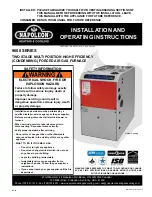
31
Check the burner flames for:
1. Good adjustment
2. Stable, soft and blue
3. Not curling, floating, or lifting off.
Burner Flame
XVII. SAFETY CIRCUIT DESCRIPTION
XVII. SAFETY CIRCUIT DESCRIPTION
XVII. SAFETY CIRCUIT DESCRIPTION
XVII. SAFETY CIRCUIT DESCRIPTION
XVII. SAFETY CIRCUIT DESCRIPTION
G
ENERAL
A number of safety circuits are employed to ensure safe and proper
furnace operation. These circuits serve to control any potential
safety hazards and serve as inputs in the monitoring and diagno-
sis of abnormal function. These circuits are continuously moni-
tored during furnace operation by the integrated control module.
I
NTEGRATED
C
ONTROL
M
ODULE
The integrated control module is an electronic device which, if a
potential safety concern is detected, the module will take the nec-
essary precautions and provide diagnostic information through an
LED.
P
RIMARY
L
IMIT
The primary limit control is located on the partition panel and moni-
tors heat exchanger compartment temperatures. It is a normally-
closed (electrically), automatic reset, temperature-activated sen-
sor. The limit guards against the overheating as a result of insuffi-
cient conditioned air passing over the heat exchanger.
A
UXILIARY
L
IMIT
The auxiliary limit control(s) are located on or near the circulator
blower and monitors heat exchanger compartment temperatures.
They are a normally-closed (electrically), manual-reset, tempera-
ture activated sensors. These limits guard against overheating as
a result of insufficient conditioned air passing over the heat ex-
changer.
R
OLLOUT
L
IMIT
The rollout limit controls are mounted on the burner/manifold as-
sembly and monitor the burner flame. They are normally-closed
(electrically), manual-reset, temperature-activated sensors. These
limits guard against burner flames not being properly drawn into
the heat exchanger.
P
RESSURE
S
WITCHES
The pressure switches are normally-open (closed during opera-
tion), single-pole single-throw, negative air pressure-activated
switches. They monitor the airflow (combustion air and flue prod-
ucts) through the heat exchanger via pressure taps located on the
induced draft blower and the coil front cover. These switches guard
against insufficient airflow (combustion air and flue products)
through the heat exchanger and/or blocked condensate drain con-
ditions.
F
LAME
S
ENSOR
The flame sensor is a probe mounted to the burner/manifold as-
sembly which uses the principle of flame rectification to determine
the presence or absence of flame.
XVIII. TROUBLESHOOTING
XVIII. TROUBLESHOOTING
XVIII. TROUBLESHOOTING
XVIII. TROUBLESHOOTING
XVIII. TROUBLESHOOTING
E
LECTROSTATIC
D
ISCHARGE
(ESD) P
RECAUTIONS
NOTE:
Discharge body’s static electricity before touching unit. An
electrostatic discharge can adversely affect electrical components.
Use the following precautions during furnace installation and ser-
vicing to protect the integrated control module from damage. By
putting the furnace, the control, and the person at the same electro-
static potential, these steps will help avoid exposing the integrated
control module to electrostatic discharge. This procedure is appli-
cable to both installed and uninstalled (ungrounded) furnaces.
1.
Disconnect all power to the furnace. Do not touch the
integrated control module or any wire connected to the control
prior to discharging your body’s electrostatic charge to
ground.
2.
Firmly touch a clean, unpainted, metal surface of the
furnaces near the control. Any tools held in a person’s
hand during grounding will be discharged.
3.
Service integrated control module or connecting wiring
following the discharge process in step 2. Use caution not
to recharge your body with static electricity; (i.e., do not move
or shuffle your feet, do not touch ungrounded objects, etc.).
If you come in contact with an ungrounded object, repeat
step 2 before touching control or wires.
4.
Discharge your body to ground before removing a new
control from its container. Follow steps 1 through 3 if
installing the control on a furnace. Return any old or new
controls to their containers before touching any ungrounded
object.
D
IAGNOSTIC
C
HART
WARNING
T
O AVOID ELECTRICAL SHOCK, INJURY OR DEATH, DISCONNECT ELECTRICAL
POWER BEFORE PERFORMING ANY SERVICE OR MAINTENANCE.
Refer to the
Troubleshooting Chart
at the end of this manual for
assistance in determining the source of unit operational problems.
The red diagnostic LED blinks to assist in troubleshooting the unit.
The number of blinks refers to a specific fault code.
R
ESETTING
F
ROM
L
OCKOUT
Furnace lockout results when a furnace is unable to achieve igni-
tion after three attempts during a single call for heat. It is character-
ized by a non-functioning furnace and a one flash diagnostic LED
code. If the furnace is in “lockout”, it will (or can be) reset in any of
the following ways.
1.
Automatic reset. The integrated control module will
automatically reset itself and attempt to resume normal
operations following a one hour lockout period.
2.
Manual power interruption. Interrupt 115 volt power to the
furnace for 1 - 20 seconds.
3.
Manual thermostat cycle. Lower the thermostat so that
there is no longer a call for heat then reset to previous setting.
Interrupt thermostat signal to the furnace for 1 - 20 seconds.
NOTE:
If the condition which originally caused the lockout still
exists, the control will return to lockout. Refer to
Section XVIII,
Troubleshooting - Diagnostic Chart
for aid in determining the cause.
Содержание GMS95
Страница 34: ...34...







































